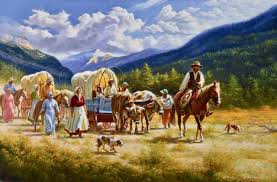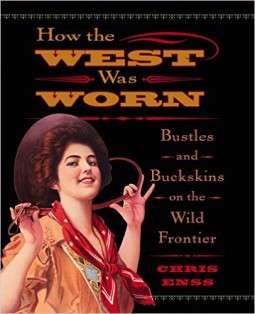Enter now to win a copy of
How the West Was Worn: Bustles and Buckskins on the Wild Frontier
The pilgrimage west was an arduous undertaking. Emigrants hurriedly loaded their wagon trains with as many personal belongings as they could, and if they were unable to make what little they had fit, it was left behind. Limited space forced many to wear all the clothing they owned on their backs. The basic outfit for a pioneer woman consisted of a gingham or calico dress, a sunbonnet, and a muslin apron. Men pioneers wore simple overalls, cotton work shirts, and caps or broad-brimmed hats.
Many who made the trek were poor, possessing only a single pair of boots or shoes, the soles of which would be worn off long before arriving at their final destination. Socks wore out as well, forcing settlers to wrap their feet in rags to protect them from the elements. When traveling through snow and ice, they wrapped their footwear in gunnysacks to keep their feet from freezing.
In preparation for the trip, women altered their dresses to make walking easier. Several inches were cut off the bottom of the skirt and lead shot was sewn into the hem to keep the billowing material from blowing in the wind. Men wore their trouser legs tucked into their boots for the same reason. Wearing them in this manner also kept out mud and reptiles. Pioneer women’s dresses were worn without a hoop, and the bodice was lined with canvas for strength and warmth.
Before heading west, pioneers consulted guidebooks for advice on suitable dress for the trip, and how to best protect the body against the direct rays of the sun and sudden changes in temperature. If they acquired the necessary items listed, travelers were assured to be prepared for any possible condition.
The following list of articles was deemed a sufficient outfit of on man up on a three month’s expedition:
2 blue or red flannel overshirts, open in front with buttons
2 woolen undershirts
2 pair of thick cotton drawers
4 pair woolen socks
2 pair cotton socks
4 silk handkerchiefs
3 towels
1 comb and brush
1 gutta percha poncho
2 pair of stout shoes
1 pound of Castile soap
3 pounds bar soap for washing clothes
1 bed-knife and small whet stone

How the West Was Worn 2
I'm looking forward to hearing from you! Please fill out this form and I will get in touch with you if you are the winner.
Join my email news list to enter the giveaway.
"*" indicates required fields
To learn more about dressing for travel in the West read
How the West Was Worn: Bustles and Buckskins on the Wild Frontier







